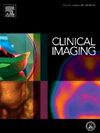4D血流心脏磁共振在小儿先天性心脏病中的应用:来自四年多临床实践的见解
IF 1.8
4区 医学
Q3 RADIOLOGY, NUCLEAR MEDICINE & MEDICAL IMAGING
引用次数: 0
摘要
背景:先天性心脏病(CHDs)是常见的先天性缺陷。本文介绍了4年多来心血管磁共振(CMR)的临床经验,强调了其在小儿冠心病中的价值。方法:对298例不同诊断的CHD患儿进行自由呼吸呼吸补偿4D血流CMR 1.5 T或3t扫描检查。图像体积在轴向上获得,覆盖整个心脏和主要血管。系统地进行了与参考标准的直接比较。结果:与传统的二维血流CMR相比,4D血流CMR在保持峰值流速、Q和Qp/Qs (R = 0.9-1.0)的准确度的同时,对复杂的心血管疾病提供了更详细的见解。4D血流CMR在瓣膜功能、狭窄和分流评估方面的优势尤为明显。然而,我们的研究结果强调需要额外的校正来解决部分容积(灌注比误差高达180%)和贯穿平面的心脏运动影响(主动脉/肺反流容积误差高达25/ 10ml)。结论:总的来说,4D血流CMR被证明是一种全面的诊断工具,增强了对儿童冠心病的认识和管理,有可能改变治疗过程。本文章由计算机程序翻译,如有差异,请以英文原文为准。

4D flow cardiac magnetic resonance in pediatric congenital heart disease: Insights from over four years of clinical practice
Background
Congenital heart diseases (CHDs) are common birth defects. This work presents over four years of clinical experience of 4D flow cardiovascular magnetic resonance (CMR), highlighting its value for pediatric CHD.
Methods
Children with various CHD diagnoses (n = 298) were examined on a 1.5 or 3 T scanner using 4D flow CMR in free breathing with respiratory compensation. The image volume was acquired in axial orientation, covering the entire heart and major vessels. Head-to-head comparisons with reference standards were systematically performed.
Results
4D flow CMR provided more detailed insights into complex cardiovascular conditions while maintaining a comparable level of accuracy in peak velocity, Q and Qp/Qs (R = 0.9–1.0) compared to conventional 2D flow CMR. The advantages of 4D flow CMR were particularly evident for valve function, stenosis, and shunt assessments. However, our findings emphasize the need for additional corrections to address partial volume (up to 180 % error in perfusion ratio) and through-plane cardiac motion effects (up to 25/10 ml error in aortic/pulmonary regurgitation volume).
Conclusion
Overall, 4D flow CMR proved to be a comprehensive diagnostic tool that enhanced the understanding and management of pediatric CHD, potentially changing the course of the treatment.
求助全文
通过发布文献求助,成功后即可免费获取论文全文。
去求助
来源期刊

Clinical Imaging
医学-核医学
CiteScore
4.60
自引率
0.00%
发文量
265
审稿时长
35 days
期刊介绍:
The mission of Clinical Imaging is to publish, in a timely manner, the very best radiology research from the United States and around the world with special attention to the impact of medical imaging on patient care. The journal''s publications cover all imaging modalities, radiology issues related to patients, policy and practice improvements, and clinically-oriented imaging physics and informatics. The journal is a valuable resource for practicing radiologists, radiologists-in-training and other clinicians with an interest in imaging. Papers are carefully peer-reviewed and selected by our experienced subject editors who are leading experts spanning the range of imaging sub-specialties, which include:
-Body Imaging-
Breast Imaging-
Cardiothoracic Imaging-
Imaging Physics and Informatics-
Molecular Imaging and Nuclear Medicine-
Musculoskeletal and Emergency Imaging-
Neuroradiology-
Practice, Policy & Education-
Pediatric Imaging-
Vascular and Interventional Radiology
 求助内容:
求助内容: 应助结果提醒方式:
应助结果提醒方式:


